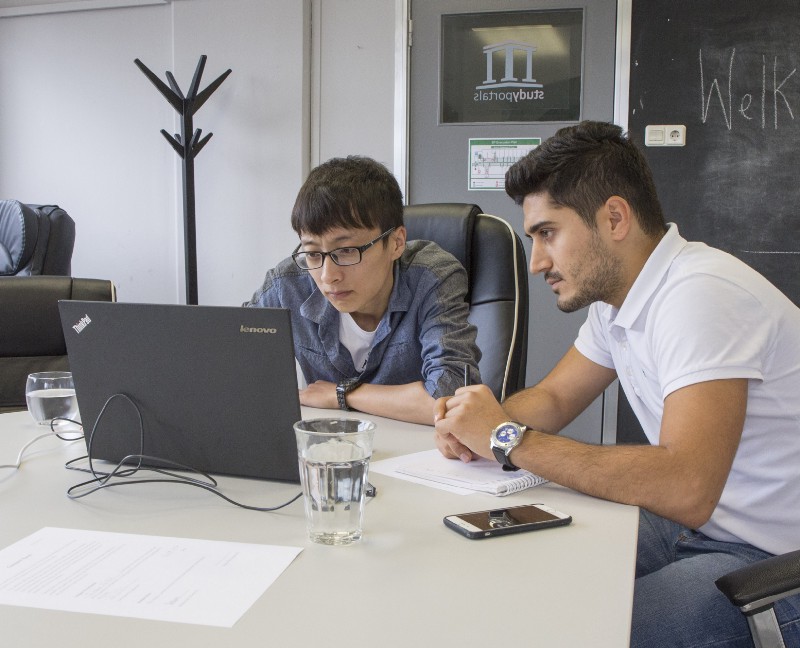New series: product innovation at Studyportals

Over the next few weeks, we will be producing a series of articles that document the processes and steps we take towards improving and innovating our product. By understanding the student journey in and out, we’ll show how a platform can be built that is valuable to students and agile to the demands of international education.
Stay tuned and see the various insights we continue to gain as we continue to build, adapt, and create the biggest education search platform, bringing absolute transparency and reliability to international education.
Introduction to the series
What distinguishes the best online experiences from the worst? Lots and lots of research and design iterations. It takes a great deal of work to build and maintain an intuitive and cohesive user experience. Anyone who’s involved in creative innovation and product development knows that they must always be responsive and willing to adapt. Being responsive means having the capacity to change your methods, ideas, and products according to the needs of your audience, customers, or users.
One of the major challenges is finding out what users truly want and what, often unconsciously, motivates them to perform certain actions. A quote from a former ethnographic researcher, Margaret Mead, is spot on about why it’s so difficult – and why thorough research is so important.

At Studyportals, engineers and developers design our online platforms – Mastersportal, Bachelorsportal, DistanceLearningportal, etc. – according to what best serves students worldwide. The ability to do this, however, requires not only strategic planning and versatility; it requires a strong informational edifice and data system taken directly from students themselves. What are students asking? What information do they need? What steps do they take? How do they approach their search for international education? These questions are crucial ones we ask so that we can build the global search platform for students, and, simultaneously, a place for universities to enhance their online international recruitment efforts.
The steps to enrolment
To get to basics, let us think about what steps students take before they decide to study abroad and enrol in a degree programme. There first needs to be an interest – an interest either in studying abroad, in finding a degree programme or simply exploring the world. But, the question remains: how do we tap into that interest in a way that it turns into an action?
Going down this student path or journey often elicits a series of questions, concerns, and uncertainties. And, unless students can eliminate these, they are unlikely to proceed forward. Think about it: would you buy a product if you weren’t sure you could afford it? Would you stay in a hotel without knowing whether it has a pool? Would you hire someone for a job without seeing any references or experience? Students, too, have a similar mentality when it comes to negotiating their education. Pursuing an international education is a big, exciting, and, yet, complicated venture. Getting there requires confidence, awareness, and inspiration.
Determining students’ needs
Over the years, we’ve found that students are hesitant about making big decisions until they have all of the information they need. We’ve also learned that each student has different needs. They can be career considerations, economic hardships, language barriers, and general anxieties that could all be preventing them from studying abroad.
Therefore, it’s important, that the online platform we build is able to accommodate the various needs of students.
Though, as the education landscape continues to change, along with the political, social, and economic climate, students’ concerns shape with them. Therefore, the platform must be an ever-evolving one, constantly changing and adapting.
The focus, in this respect, is to be fully student-centered. We place our entire energy and focus on knowing what students are demanding, allowing them to be the main architects of our online platform. So long as we put the students at centre stage, using their voices and perspectives to guide our product, then we can make a product that is designed especially and exclusively for them.
Ways to understand students’ needs
To keep up-to-speed with every different change and unique demands that students have, we take a series of steps to determine students’ needs.
-
Surveys
We will often send surveys to our registered student users, asking them about the information they look for and need when they search for education options. From the data we gather, we are able to determine what things most students ask for and what kind of information is missing from them. Afterwards, we develop our thought patterns and ideas based on the responses we receive.
-
User tests
Here at our office, we host user tests, asking local area students to use our portals and see how intuitive it is to them. This gives us a lot of valuable information, getting personal reflections and responses to our platform, and seeing whether everything we provide is usable and navigable from the perspective of the average user. This method, too, gives us a chance to then change anything around that may not be intuitive to users, or may not interest them if they’re searching for education options.

-
Google Analytics
Google Analytics allows us to see whether users are not only finding our platform but are using it and staying on the web page, without deciding to go elsewhere. By seeing how much traffic we generate and what the behaviour of users is, we can determine whether the site has information that they find useful or interesting. Based on the organic traffic (i.e. traffic from Google), we can assess whether the users are finding the direct information that they’re searching for on our site, and that we’ve made it findable and discoverable.
-
In-depth interviews
Occasionally, we’ll also conduct interviews with students, either in a one-on-one format or as part of a focus group. During these interviews, we offer a domain for students to share their experiences and tell us what they would tend to expect when they’re searching for their education options. These are not merely limited to user behaviour; rather, we get to ask broader questions about searching for education options and deciding to study abroad. Through these discussions, we get to know what students attitudes are, giving us a more subjective, human side to complement the numbers and metrics that we’ve received.
Applying each of these methods simultaneously, we gain plenty of insights into what users want and how they think. As a result, we’re able to adapt the things we display on our site in a manner that appeals to our users and compels them to fulfil their dreams of studying abroad.
How responsive product innovation can help student recruitment
If you’re part of a university, it’s important that you remain equally concerned with students’ needs and behaviours. Luckily, with the work that our developers put towards understanding students needs, we design our online listings in a manner that makes universities and institutions shine. How? Simply put, if you provide students with the information they’re looking for as they are looking for it, then they are more likely to take action and apply.
To think of another example: if you’re thinking of purchasing a computer, you’re more likely to immediately buy the one where the price is explicitly listed than you are to buy the one where you can’t find a price at all.
For universities, students are asking questions about whether they qualify for admission, whether they can afford it, or whether it will benefit their careers. If a university provides this information in a clear, intuitive manner, then the university is more likely to stand out in a student’s mind. So, if we commit ourselves to developing a product and platform with information that students expect or demand, then we can also ensure that universities have a prominent place along the student’s journey.
Further reading
- Part III – Improving search results
- Part II – Insights into visa requirements
- Part I – Transparency about student admission chances
For more updates, follow us!





